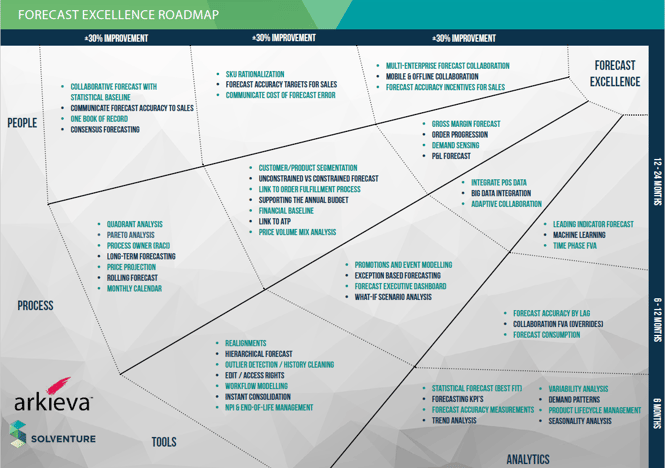
The answer is simple. If someone makes you that promise: run away, it’s a trap!
What would you say if I told you I know the recipe to become a billionaire in 5 days? You won’t trust me, right? Also, if I had the answer I would probably not be writing this blog but rather be chilling on the beach in Mexico (still probably reading supply chain articles).
Seriously though, I got a call from a Solventure customer located in the UK earlier this week, asking me: “How can I improve my forecast in a very short period of time?”. So, I started to do what consultants like to do: asking questions. The following 3 questions formed the baseline of our discussion.
Improving the forecast is not the goal, it is the means to get to a goal. So, before deciding to improve your forecast you should be able to explain why you want to do it. Do you want to improve your production planning stability, your financial projection, or your cash requirement estimate? Are all your products and customers equally important from an accuracy standpoint? Depending on the goal, your approach for forecast improvement could be totally different.
In most cases, people will not know where they are and where they want to be. I recall from my university classes one professor stating: “You cannot improve what you cannot measure”. There is a very known and simple methodology that you can use which is called PDCA. It stands for plan, do, check, act. My point being that improving the forecast is not a one-off. It’s a journey if you want to reach excellence. Exactly what I said earlier: you cannot be a billionaire in 5 days.
I always like to compare it with other things. One of the examples I can think of is SEO (search engine optimization). You cannot expect to rank 1st position on google just because you put 1 day of work, one moment in time. This will just NOT work. Forecast improvement is the same: it’s a long journey that can take 6-24months before you reach your final target.
So my advice is to set short-term achievable and measurable targets but in a long-term vision and objective. It’s about the improvement mindset. Use manufacturing concepts to broaden your goals: lean, continuous improvement, 6sigma, …
If you are interested in knowing how to set targets, you can find more information in the strategic benchmarking blog, here.
Most people think that a tool is going to solve everything. Nothing is more wrong than that. The forecast journey needs to be supported from 4 different angles: people, process, tools, and analytics. This is also how we approach successful projects at Solventure, read more about it here. There are improvement initiatives that can be more short-term and others long-term. At Solventure we have defined a roadmap to give you an idea of how you can structure that LONG-TERM forecast improvement journey. The excellence forecast roadmap is structured around those 4 angles (people, process, tools, and analytics) with a timeline attached to it. It doesn’t mean that the exact roadmap will be leveraged by your organization but you can take it as a point of reference to create your own roadmap.

I hope this blog could serve as an eye-opener for you to understand that forecast improvement is not something you set up in 5 days. On the positive side, if your competitors don’t have a long-term vision on this matter, you have just identified a potential competitive advantage. So, grab this opportunity to turn your supply chain into a competitive edge and drive value from it.
If you want to know more about forecast accuracy, we’ll be happy to assist you. Schedule a free 30-minute call with Solventure, and we’ll dive deeper into your challenges.
These Stories on Executive S&OP